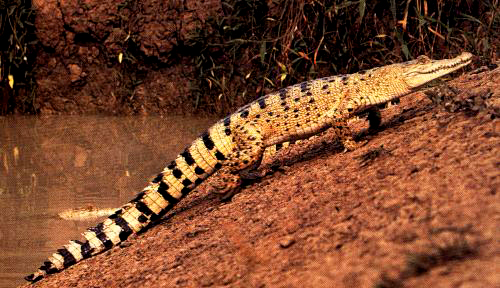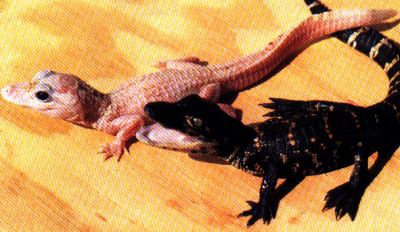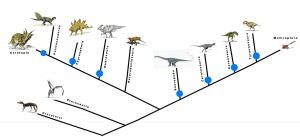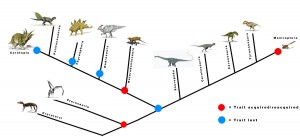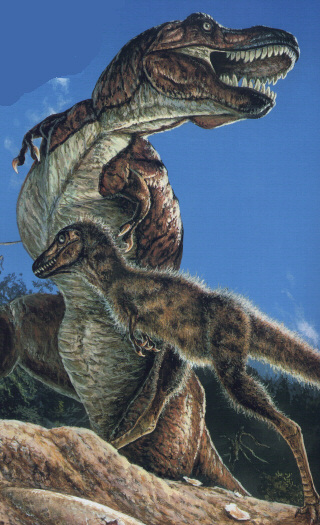
Just announced today in the journal: PNAS, is a new comprehensive study on Komodo dragon feeding ecology. The comprehensive nature of the paper is the result of the contributions from around 28 individuals from all over Australia, as well as the Netherlands, and Switzerland.
The paper in question is:
Fry, B., Wroe, S., Teeuwissed, W., van Osch, M.J.P., Moreno, K., Ingle, J., McHenry, C., Ferrara, T., Clausen, P., Scheib, H., Winter, K.L., Greisman, L., Roelants, K., van der Weerd, L., Clemente, C.J., Giannakis, E., Hodgson, W.C., Luz, S., Martelli, P., Krishnasamy, K., Kochva, E., Kwok, H.F., Scanlon, D., Karas, J., Citron, D.M., Goldstein, E.J.C., Mcnaughtan, J.E., and Norman, J. 2009. A Central role for Venom in Predation by Varanus komodoensis (Komodo Dragon) and the Extinct Giant Varanus (Megalania) prisca. PNAS Early Release. doi:10.1073/pnas.0810883106
*catches breath*
The paper is only six pages long, which downplays just how much work must have gone into this project. The authors used Finite Element Analysis, MRIs, and traditional biochemical and dissectional techniques to look deep into the venom apparatus of the living Komodo dragon (V. komodensis).
For those who may have missed it on the first go around, it has recently been discovered that venom is more widespread among squamates than previously thought (Fry et al 2005). The authors of that paper (a few of whom are on this paper) found the presence of specific glands at the base of the mandible in numerous lizard species. These glands were found to release salivary proteins that were, in fact, venom.
It was a “primitive” venom for the most part, with little denaturing, or tissue destroying properties, but enough that it seemed to warrant the construction of a new clade of squamates named: Toxicofera (Fry et al 2005, Vidal & Hedges 2009). Though the discovery of incipient venom production in many squamates, was an intriguing surprise, the resultant cladogram has proven problematic, and controversial. The authors found iguanians (iguanas, chameleons, most pet lizards) to be deeply nested within scleroglossa (skinks, snakes, varanids); a view that flies in the face of every morphological study ever done on this group (e.g. Romer 1956, Pianka and Vitt 2003). In order for Toxicofera’s current associations to be valid, iguanians would have to have re-evolved both their temporal bars, as well as a fleshy tongue. While possible (few things in evolution are impossible), it is extremely unlikely; kind of like expecting snakes to re-evolve limbs.
Despite this contentious relationship, the discovery of venom glands in animals like monitor lizards, was a surprise. This new study by Fry et al is the first to really look at the venom secreting abilities of this gland, and what it means to Komodo dragon ecology.
![Photo by: Jeff Werner [Fauna vol.1 number 3 Mar 98]](https://reptilis.net/index4/komodo2.jpg)
It turns out that the mandibular venom gland in V.komodoensishas six different compartments that open between the teeth of the lower jaw. Unlike venomous snakes and helodermatid lizards, the venom does not travel through any grooves in the teeth. Rather, it appears to pool at their base; bathing the teeth of the lower jaw prior to biting a prey animal. It’s a crude method of venom delivery, but one that might explain why Komodo dragons have such thick gums (which the teeth erupt through during a bite).
According to the authors, the mandibular venom gland of a 1.6m (5.25ft) Komodo dragon has enough fluid to produce 150mg of venom; 30mg of which would be available for delivery. That’s a fair amount of venom, but how does that translate to toxicity?
Though the delivery method is crude, the venom is fairly potent. According to the authors it only takes 0.1mg/kg of venom in the blood stream to cause pronounced hypotension, and only 0.4mg/kg to cause hypotensive collapse (fainting).
To put this into perspective, I weigh approximately 76kg (168lbs). It would take approximately 7.6mg of Komodo dragon venom to make me light headed, and 30mg to knock my arse out.
Hmm, maybe I should reconsider that Komodo island trip?
Fry et al go on to discuss how V.komodoensis goes about using this venom delivery system during predation. It was at this point that I became a bit hesitant.
Komodo dragon feeding ecology has been the subject of much misconception. Much like dinosaurs, earlier work on these beasts was more accurate than the work that soon followed. When Komodo dragons were first discovered, they were thought to be scary top predators of their respective habitat. This was quickly downgraded to obligate scavenger; possibly due to the animal’s willingness to eat prekilled meat, but more likely from general incredulity that a large reptile can actively hunt mammals (see table 10-2 of Auffenberg 1981 for examples). It really wasn’t until Dr. Walter Auffenberg spent some 13 months in the wild with Komodo dragons, that this myth was officially dispelled, and some 20 years after for it to become common knowledge. However, once it was discovered that animals lucky enough to escape from an initial V.komodoensis attack were found to die hours/days later, the view of Komodo dragons as “bite and release” predators was born (e.g. Bakker 1986).
Auffenberg’s work did show that there is something septic about the bite of oras. This was originally attributed to bacterial flora living in the fairly dirty mouths of these predators. Indeed one study (Gillespie et al 2002) found 54 potentially pathogenic bacteria living in the mouths of oras!
However, and this is the part that always seems to get glossed over: there has never been a reported case of a komodo monitor using this “bite and release” killing strategy. Despite spending over a year living with these animals, Auffenberg never once found an animal bitten, released and then later tracked down after it died. Komodo dragon attacks were quite the opposite in fact. Small, to relatively large prey (goats, boar) were often killed on the spot using violent side to side shaking to snap the neck, while large prey like water buffalo were hamstringed (Achilles tendon severed), followed by abdominal evisceration of the now paralyzed (and often still alive) animal.
Despite the gruesome detail in which Auffenberg described ora attacks, as well as the sheer lack of evidence for a viper style feeding strategy; one can still read about how Komodo dragons “avoid confrontation with their prey” by allegedly employing this method of killing (for instance).
So one can forgive my trepidation over what was to be written about next in the Fry et al paper.
The authors do discuss the alleged “bite and release” hunting style posited for V.komodoensis, but are quick to point out (as I just did) that there has never been a documented case of this hunting strategy being used on dragon prey.Dr. Fry went went one step further in an interview for Science News:
What’s more, rare sightings of the lizards hunting didn’t fit with this method. Victims typically died quickly and quietly after going into shock, the authors say. “No one’s actually seen a Komodo dragon track a prey for three days until it dies of septicemia,” Fry says. “It’s an absolute fairy tale.”
This was very comforting to see. One can only hope that the other news outlets don’t miss this point when doing their write ups (Edit: so much for hope).
Fry et al then went on to dispel the myth that the mouth of dragons contain toxic microflora. Though there have been studies that have shown the presence of potentially pathogenic bacteria in wild oras, none of these studies found a consistent microflora between individuals. In fact, the authors point out that some of the bacteria found in Komodo dragon mouths, were the same bacteria found in the guts of most lizards.
That venom must be playing an important role in predation was determined by looking at the evolution of venom in squamates. The authors point out that:
We have shown that in the species that have developed secondary forms of prey capture (e.g., constricting) or have
switched to feeding on eggs, the reptile venom system undergoes rapid degeneration characterized by significant atrophying of the
glands, reduction in fang length, and accumulated deleterious mutations in the genes encoding for the venom proteins (9, 26,
27). This is a consequence of selection pressure against the bioenergetic cost of protein production (28). The robust glands
and high venom yield in V. komodoensis thus argue for continued active use of the venom system in V. komodoensis.
So, while the venom of Komodo dragons is not the primary means by which dragons dispatch their prey, it still must play a pretty important role in prey acquisition. Since envenomated prey tend to become docile and quiet (Auffenberg, 1981, and this paper), it may just play a role in initiating shock, and reducing retaliatory actions by prey. It may also serve as a good “failsafe” in the event of a missed kill. Bitten prey that are “lucky” enough to escape an initial attack, tend to find themselves easily preyed upon shortly thereafter. This is similar to hunting tactics seen in Canadian lynx (the only mammalian carnivores known to have a septic bite) when hunting caribou (Auffenberg 1981).

Using Finite Element Analysis, the authors compared the bite and skull strength of V.komodoensis with that of a similar sized saltwater crocodile (Crocodylus porosus). The results they obtained agreed with previous FE work on Komodo dragons (Moreno et al 2008), which found the bite of oras to be remarkably weak on its own, thus requiring the aid of the postcranial musculature in delivering much of the force. Ora skull strength is at its greatest during bite and pull behaviour. This data agrees well with field observations showing oras biting and pulling back on their prey. Coupled with their recurved and serrated teeth, this results in the creation of large, gaping wounds, which would aid in venom delivery as the ora’s venom would be spread throughout; quickly entering the bloodstream and speeding up shock.
Finally the authors extrapolated their work to the monstrous lacertilian behemoth Varanus (Megalania) prisca. Using the extant phylogenetic bracketing method (Witmer 1995, 1998), they were able to determine the likelihood of venom being present in Megalania. If true, this would make Megalania the largest venomous carnivore to have ever lived.
I’m not sure I buy this part. As Fry et al mentioned in the paper, the venom apparatus tends to degrade quickly when not used. Megalania was a big animal (over 2,000 kg according to the authors, though Molnar 2004 places it as just under 2,000kg for the largest individuals). Any hole that V(M)prisca would create when attacking its prey, would have been devastating enough without the need for anticoagulating venom.
Also:
Like the other members of this unique varanid lizard clade, the jawbones of V. prisca are also relatively gracile compared with the robust skull and the proportionally larger teeth similarly serrated (Fig. 3).
I’d be careful about this assumption, as there is only one fairly complete maxilla (upper jaw bone), and portions of the dentary (tooth bearing lower jaw bone), known for Megalania. This makes comparison with extant monitors, rather hard to do. What little skull bones do exist, show that the skull of Megalania was stronger (or at least, less flexible) than that of other monitor lizards (Molnar, 2004).
As it stands right now, there are frustratingly too few fossils of Megalania (especially the skull) to accurately say one way, or the other in regards to venom delivery.
Of course that doesn’t make it any less interesting to speculate about. 🙂
~Jura
References
Auffenberg, Walter, 1981, The Behavioral Ecology of the Komodo Monitor, Florida University press, pgs: 406.
Bakker, R. 1986. The Dinosaur Heresies. William Morrow. New York. ISBN: 0821756087, 978-0821756089 pgs: 481.
Fry, B.G., Vidal, N., Norman, J.A., Vonk, F.J., Scheib, H., Ryan Ramjan, S.F., Kuruppu, S., Fung, K., Hedges, S.B., Richardson, M.K., Hodgson, W.C., Ignjatovic, V., Summerhayes, R., Kochva, E. 2005. Early Evolution of the Venom System in Lizards and Snakes. Nature. Vol.439:584-588.
Gillespie, D., Fredekin, T., Montgomery, J.M. 2002. “Microbial Biology and Immunology” in: Komodo Dragons: Biology and Conservation. James Murphy, Claudio Ciofi, Colomba de La Panouse and Trooper Walsh (eds). pgs: 118-126. ISBN: 1588340732/978-1588340733
Molnar, R.E. 2004. Dragons in the Dust: The Paleobiology of the Giant Monitor Lizard Megalania. Indiana University Press. 210pgs. ISBN: 0253343747/978-0253343741
Moreno, K., Wroe, S., Clausen, P., McHenry, C., D’Amore, D.C., Rayfield, E.J., Cunningham, E. 2008. Cranial Performance in the Komodo Dragon (Varanus komodoensis) as Revealed by High-Resolution 3-D Finite Element Analysis. J.Anat. Vol.212:736-746.
Pianka, E.R., and Vitt, L.J. 2003. Lizards Windows to the Evolution of Diversity. U.Cal.Press. 333pgs. ISBN: 0520234014/9780520234017
Romer, A.S. 1956. The Osteology of the Reptiles. Krieger Publishing 800pgs. ISBN: 089464985X/978-0894649851
Vidal, N. and Hedges, S.B. 2009 The Molecular Evolutionary Tree of Lizards, Snakes, and Amphisbaenians. Biologies. Vol.332(2-3):129-139.
Witmer, L. 1995. “The Extant Phylogenetic Bracket and the Importance of Reconstructing Soft Tissues in Fossils” in: Functional Morphology in Vertebrate Paleontology. Jeff Thomason (ed). Cambridge Univ. Press. Cambridge, UK. pgs 19-33. ISBN 0521629217/978-0521629218
Witmer, L. M. 1998. Application of the Extant Phylogenetic Bracket (EPB) Approach to the Problem of Anatomical Novelty in the Fossil Record. J.Vert.Paleo. Vol.18(3:Suppl.): 87A.

